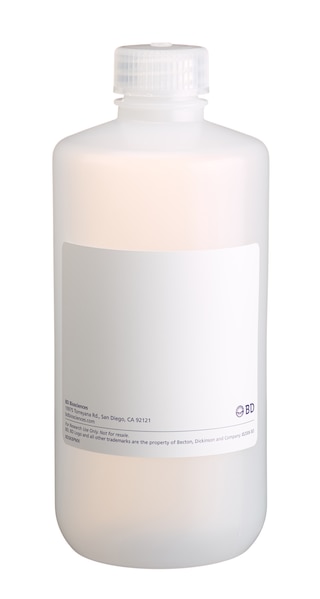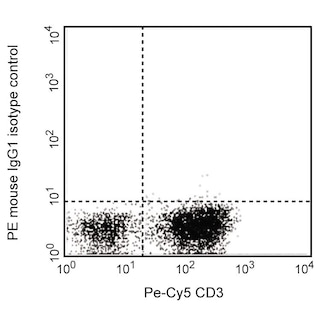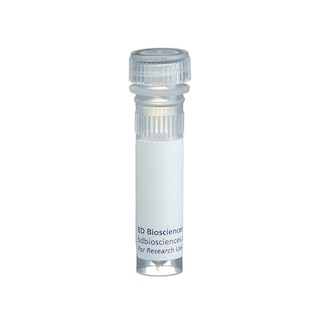Old Browser
This page has been recently translated and is available in French now.
Looks like you're visiting us from {countryName}.
Would you like to stay on the current country site or be switched to your country?


.png)

Flow cytometric analysis of CD119 expression on human PBMC isolated by Lymphoprep (Nycomed) density centrifugation. Whole blood was stained either with PE Mouse IgG1, κ Isotype Control (Cat. No. 554680; open histogram) or PE Mouse Anti-Human CD119 (Cat. No. 558934/558937/557531; filled histogram) The fluorescence histograms were derived from gated events with the forward and side light-scattering characteristics of viable cells.
.png)

BD Pharmingen™ PE Mouse Anti-Human CD119
.png)
Regulatory Status Legend
Any use of products other than the permitted use without the express written authorization of Becton, Dickinson and Company is strictly prohibited.
Preparation And Storage
Recommended Assay Procedures
Immunofluorescent staining and flow cytometric analysis: PE Mouse Anti-Human CD119 (Cat. No. 558934) can be used for the immunofluorescent staining (≤ 1 µg antibody/10[6] cells) and flow cytometric analysis of the levels of membrane IFN-γRα expressed by human cell lines or human lymphoid cells. An appropriate R-PE conjugated immunoglobulin isotype control is the PE Mouse IgG1, κ Isotype Control (Cat. No. 554680).
Since GIR-208 is a neutralizing antibody, it competes with IFN-γ for binding to its receptor. Therefore, the use of the GIR-208 antibody for
immunofluorescent staining and flow cytometric analysis in systems where the natural ligand of the receptor is present may give an underestimation of IFN-γRα chain expression. Based on our testing results, the presence of recombinant human IFN-γ protein at levels above 200 ng/ml is sufficient to completely inhibit the binding of the GIR-208 antibody (at 0.06 µg/10[6] cells). In such cases, it is recommended that the investigator uses a non-neutralizing antibody to detect IFN-γRα chain expression by flow cytometry, such as PE Mouse Anti-Human CD119 (Cat. No. 558937).
WB: The GIR-208 antibody has been reported to be useful for Western blotting. Please note that this application is not routinely tested at BD Biosciences Pharmingen.
Product Notices
- Since applications vary, each investigator should titrate the reagent to obtain optimal results.
- An isotype control should be used at the same concentration as the antibody of interest.
- Caution: Sodium azide yields highly toxic hydrazoic acid under acidic conditions. Dilute azide compounds in running water before discarding to avoid accumulation of potentially explosive deposits in plumbing.
- For fluorochrome spectra and suitable instrument settings, please refer to our Multicolor Flow Cytometry web page at www.bdbiosciences.com/colors.
- Please refer to www.bdbiosciences.com/us/s/resources for technical protocols.
Companion Products





The GIR-208 antibody recognizes the extracellular region of CD119 which is also known as the alpha chain subunit (80-95 kDa glycoprotein) of the human interferon-γ receptor (IFN-γRα). The functionally active-form of the human IFN-γ receptor consists of two (or more) subunits, with IFN-γRα responsible for IFN-γ binding and both the IFN-γRα and β chains required for the transduction of biologic responses. The IFN-γ receptor α chain (CD119) is expressed on the surface of most human cells (except mature erythrocytes) including monocytes, macrophages, T cells, B cells, NK cells, neutrophils, fibroblasts, epithelial cells, and endothelium. Binding of 125I-labeled GIR-208 antibody to IFN-γRα+ cells is reported to be specifically inhibited in the presence of excess IFN-γ. GIR-208 does not cross react with IFN-γ as tested by ELISA. The ability of this antibody to bind to IFN-γ receptors of species other than human has not been determined. The immunogen used to generate this hybridoma was human IFN-γRα purified from human placenta. The GIR- 208 has been reported to block the binding of 125I-human IFN-γ to IFN-γRα+ cells as well as purified, soluble human IFN-γRα. GIR-208 is a neutralizing antibody that has been shown to neutralize the anti-viral activity of IFN-γ on WISH cells in a dose-dependent fashion.

Development References (6)
-
Bach EA, Aguet M, Schreiber RD. The IFN gamma receptor: a paradigm for cytokine receptor signaling. Annu Rev Immunol. 1997; 15:563-591. (Biology). View Reference
-
Gumina RJ, Freire-Moar J, DeYoung L, Webb DR, Devens BH. Transduction of the IFN-gamma signal for HLA-DR expression in the promonocytic line THP-1 involves a late-acting PKC activity. Cell Immunol. 1991; 138(2):265-279. (Clone-specific: Neutralization). View Reference
-
Kishimoto T. Tadamitsu Kishimoto .. et al., ed. Leucocyte typing VI : white cell differentiation antigens : proceedings of the sixth international workshop and conference held in Kobe, Japan, 10-14 November 1996. New York: Garland Pub.; 1997:818-821.
-
Peyman JA, Hammond GL. Localization of IFN-gamma receptor in first trimester placenta to trophoblasts but lack of stimulation of HLA-DRA, -DRB, or invariant chain mRNA expression by IFN-gamma. J Immunol. 1992; 149(8):2675-2680. (Biology). View Reference
-
Sheehan KC, Calderon J, Schreiber RD. Generation and characterization of monoclonal antibodies specific for the human IFN-gamma receptor. J Immunol. 1988; 140(12):4231-4237. (Immunogen: Neutralization, Western blot). View Reference
-
Valente G, Ozmen L, Novelli F. Distribution of interferon-gamma receptor in human tissues. Eur J Immunol. 1992; 22(9):2403-2412. (Biology). View Reference
Please refer to Support Documents for Quality Certificates
Global - Refer to manufacturer's instructions for use and related User Manuals and Technical data sheets before using this products as described
Comparisons, where applicable, are made against older BD Technology, manual methods or are general performance claims. Comparisons are not made against non-BD technologies, unless otherwise noted.
For Research Use Only. Not for use in diagnostic or therapeutic procedures.
Report a Site Issue
This form is intended to help us improve our website experience. For other support, please visit our Contact Us page.